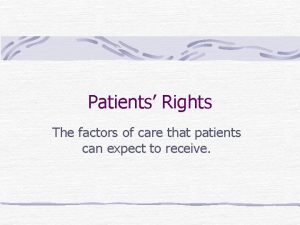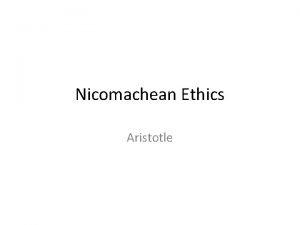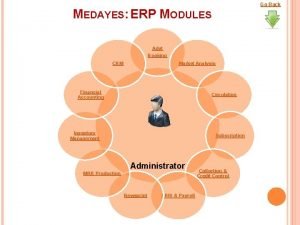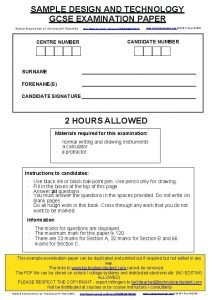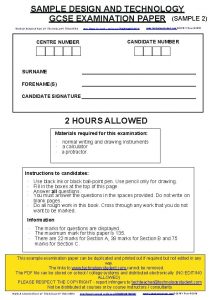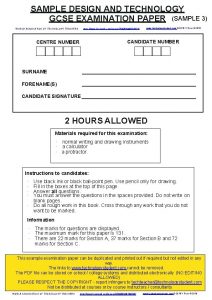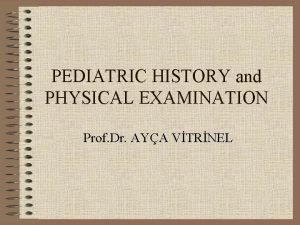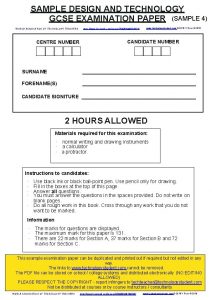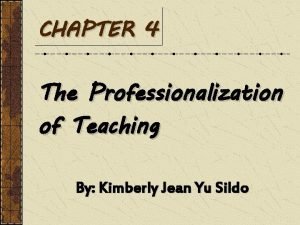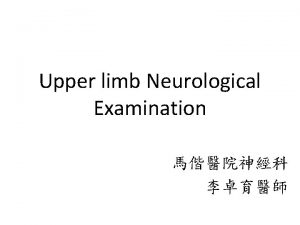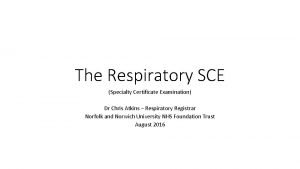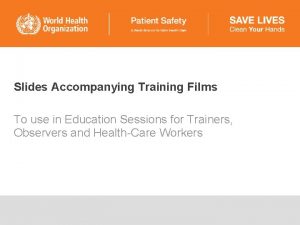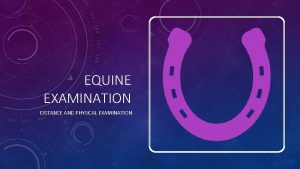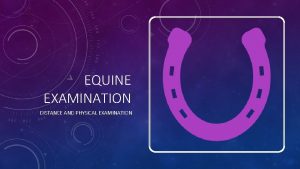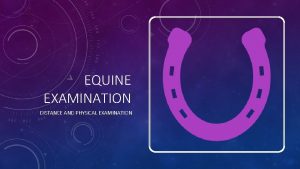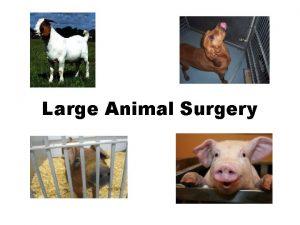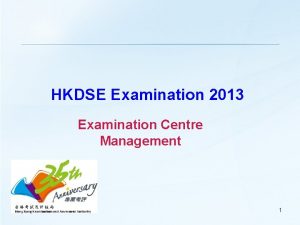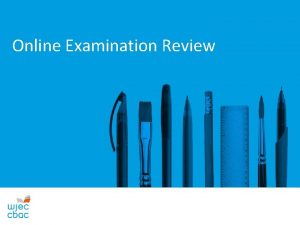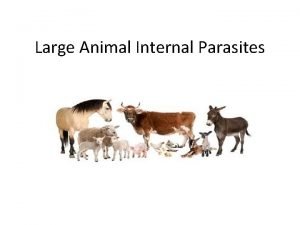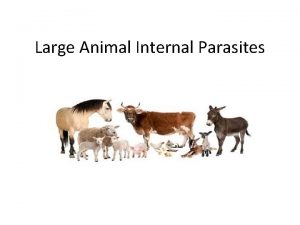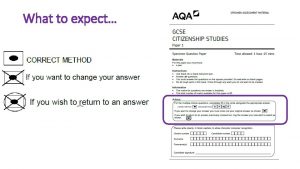ECVS examination what to expect Large Animal and







































- Slides: 39

ECVS examination: what to expect? Large Animal and Small Animal examination

Content • How to prepare for the examination • Case based part • Practical part • MCQ part • Pass mark • Exam results

Examination guide: read carefully!

How to prepare for the examination? • These slides are intended as advice – not strict rules • Nothing can replace the interaction with your supervisor(s)

How to prepare for the examination? • Study regularly • Good training & supervision • Practice mock exams • Learn to “read the question”

How to prepare for the examination? • Do the brief mock exam on ECVS homepage https: //www. ecvs. org/membership/board_examination. php#mockexam

How to prepare for the examination? • Sleep, eat! • Be in good health – exam is in the winter in Switzerland! • Be prepared : Take time to arrive in Zurich & get settled

The days of the exam • Arrive early – the exam can’t wait for you! • Try not to do last minute cramming - it just stresses you out more • Try to avoid looking up answers to questions you guessed on! • You will get some wrong • Nobody is expecting you to get all questions right • You don’t remember the ones that you got right – it will make you feel worse • Try to avoid talking about the questions! • No one feels good about it!

Where does the examination take place? • Case-based, Practical and MCQ • Vetsuisse Faculty Winterthurer Strasse 260, 8057 Zurich, Switzerland

Case-based examination • Case based “will assess a candidate`s ability to manage a case prior to, during, and after surgery. Candidates will be required to interpret medical data and make decisions based on the information available to them. Candidates will be expected to answer questions covering all areas of surgical practice” (ECVS Examination Guide, Sept 2019)

Case-based examination • Case based examination describes common conditions • The way the case evolves can be unusual but the initial presentation shouldn’t be • Case based examination progresses through presentation, diagnosis and surgical treatment • Often involves how to manage complications, postop care etc • Case-based tests experience and practical skills

Case-based examination • Two sessions of 2 hrs duration each • Fully electronically • Each candidate works on an individual computer • 6 cases with 10 questions each (3 cases per session) • Areas that my be covered: Soft tissue, ortho, neurosurgery (SA), farm animal surgery (LA) • Progressive exam with one question per page • You can turn back to previous pages but you cannot modify the answers anymore • You can answer the cases in the order you choose but you must follow the sequence of questions within each case • You can switch between cases as you wish • Images, videos and other medical information can be provided on the screens

No break. Snacks and drinks provided when entering the room. Not allowed to leave the room before completing the exam other than to visit the lavatory. Examination room : each candidate is seated in front of a computer

Notes (will not be saved) Case-based examination Calculator

Case-based examination • Individual time management: Candidate`s responsibility! • Short written answers in English • If a question asks for specific number of responses, the examiners will only mark the number of responses requested (in the order they were written down) • No negative marking • Once the candidate is done, he/she can logout, sign out and leave the room

Is there a format to write my answers? • If English is not your first language and you are stuck for the exact word, write down the word in your own language and examiners will try and translate • Common abbreviations are acceptable (ie SDFT, DIPJ etc) • The whole answer has to make sense • Don’t agglomerate words thinking the examiner will just extract the keywords and give you credits for it • List means LIST – you do not need to add further explanations

Is there a format to write my answers? • Make sure that you answer the question asked eg. List 4 methods to go from point A to point B • • A blue car A yellow car A red car A purple car a bike a bus a train Wrong! These are the same method

Example: List FOUR different causes of pyloric outflow obstruction in dogs. 1: Adenocarcinoma 2: Sarcoma 3: Lymphoma 4: Mast cell tumour This answer is WRONG Note different causes – you can‘t put different types of neoplasia Different versus specific.

Example: List FOUR different causes of pyloric outflow obstruction in dogs. 1: Neoplasia 2: Granuloma 3: Foreign body 4: Muscular hypertrophy (Accept mucosal hyperplasia)

What does “Be specific” mean? Example: • According to a recent study (White, JSAP 2011) laryngoplasty can be successfully used to treat laryngeal collapse. Describe the main steps of the laryngoplasty as used by the author. Be specific. • left-sided cricoarytenoid lateralisation combined with thyroarytenoid caudolateralisaton procedure. Complete arytenoid disarticulation and interarytenoid band transected • 1 mark for CAL and TAL combined , 1 mark for IA band transected and complete disarticulation. • It is helpful to think how you would describe the technique to a colleague over the phone • Cut the skin, dissect thyropharyngeus, place stay suture on thyroid cartilage • = NOT SPECIFIC = 0 marks • Tying back laryngeal cartilages = too vague = 0 marks

Example: What is the structure identified by the arrow? Be specific. Answer: Talus Lateral trochlear ridge of the talus

Read the question • Every year candidates fail not because of lack of knowledge but because they do not read the questions properly • Every point counts

Read the question Example: • List 4 methods of treatment of osteomyelitis in dogs 1. 2. 3. 4. Metronidazole Gentamycin Neomycin Lincomycin This question is asking for methods- If you list 4 different antibiotics, even if they are all efficacious against the disease, this is a wrong answer.

Read the question • If the question is asking for a specific number of answers, then only that number of answers will be marked in the order that you write them • If not specified you can write as many as you like • Cases are quite realistic: something unexpected can develop but you might also be presented with normal findings/images/results that are normal

Understand that a correct answer often has several components

Practical examination • “Designed to test recognition and interpretative skills” (ECVS Examination Guide Sept 2019) • Fully electronically on individual computers on qwerty keyboards • One session of 4 hours duration • Time management is the responsibility of the candidate (free navigation) • Comprises of 15 scenarios with 3 -5 subquestions each (total 60 questions).

Practical examination • Questions relate to images or other visual material on the screen, e. g. radiographs, photographs and pictures of pathology, photographs or line diagrams of surgery, anatomical pictures, pictures of instruments… • Videoclips may be included, too. • Candidates are allowed free navigation over the 15 scenarios. • Answers may be altered throughout the exam until submission. • Short written answers in English are expected. • If a question asks for specific number of responses, the examiners will only mark the number of responses requested (in the order they were written down)

Practical examination

MCQ part • 100 questions • Delivered fully electronically on individual computers • One session of 5 hours duration • 4 answer options for each question, only 1 is correct • Find the single best answer! • 10 -20% of questions are of a general nature, 80 -90% are specific to small vs. large animal surgery • When done, the candidate can submit the exam, logout and leave the room • Snacks and drinks provided at entry of the room. Leaving the room during the exam: only for visit of lavatory

MCQ part • 4 answer multiple choice • All are “positive questions” • No – “which of the following is not true…” • PLENTY of time • Check your answers • Review the entire exam before submitting it • Don’t get sick of being there and just turn it in without review. This is your ONLY chance

MCQ part • Be aware that candidates are more likely to change their answers to the INCORRECT answer after 3 hours • Questions where you are not sure of the answer will not become more clear later in the exam • You are more likely to make the right answer if you go on your initial instinct

Marking scheme • No negative marks • Discriminator questions in the case-based and practical exam • Discriminator questions help to make judgments over borderline candidates • Discriminator questions are typically questions where candidates can make a decision that would result in the death of the patient or a catastrophic outcome

Evaluation of the exam & Setting the passing score • Case-based and Practical part: • Borderline Group Method • Two step process: • Candidate`s test results are grouped into 3 categories • Based on concept of minimally qualified candidate • Pass group, Fail group, Borderline group • Each candidate`s test is getting evaluated by 5 members of the EC: blinded, independently of each other • Calculation of the median score in the Borderline group: This is the final pass score • Double marking of each candidate`s test is done by at least 2 members of the EC: blinded, independently of each other • Review, marking and decision-making with members of the EC blinded to the candidate`s names • Standard answers are made in advance by the EC (but if correct answers become evident these are added regularly during the marking process) • If it becomes clear that all or many candidates misunderstood the same question, then this will be taken into account

Fail group Border group Pass group The Border Group Method Median Qualified Minimally Candidate (MQC)

The Border Group Method • Determines the Minimally Qualified Candidate in the border group • Established criterion references • The entire process is done preserving the anonymity of the candidates

Evaluation of the exam & Setting the passing score • MCQ: • Test evaluation fully computerized • Hofstee method is used to set the passing score • Minimum and maximum failure rates are pre-determined as well as the minimum and maximum passing score • These rates and percent scores are projected onto the actual score distribution to derive a passing score

Exam results • ALL test results are anonymous, so examiners cannot know who has passed until the code is broken • Examiners and Board members treat this information as confidential, so please don't ask them!

Exam results • Marking, standard setting and quality control takes many hours and is a painstaking process • This means results are not always going to be ready in the timeframe that candidates would like • Be patient

Good luck!
 Temperament ap psychology
Temperament ap psychology Parents impose rules and expect obedience
Parents impose rules and expect obedience Parents impose rules and expect obedience
Parents impose rules and expect obedience Food and beverage directors expect a pour cost of
Food and beverage directors expect a pour cost of Capiche etymology
Capiche etymology Plant cell vs animal cell venn diagram
Plant cell vs animal cell venn diagram Animal rights versus animal welfare
Animal rights versus animal welfare Teamwork in work immersion
Teamwork in work immersion Advice verb pattern
Advice verb pattern Factors of care a patient can expect
Factors of care a patient can expect Reemployment
Reemployment Never expect the unexpected
Never expect the unexpected Sqprs
Sqprs What do you expect to learn
What do you expect to learn Alone together why we expect
Alone together why we expect Ultra glide the watsons go to birmingham
Ultra glide the watsons go to birmingham Dont expect more
Dont expect more Expect the unexpected
Expect the unexpected Notice ikinci hali
Notice ikinci hali Expect tool
Expect tool Why had m. loisel been saving 400 francs
Why had m. loisel been saving 400 francs Venn diagram of plant and animal cell
Venn diagram of plant and animal cell Sample design and technology gcse examination paper answers
Sample design and technology gcse examination paper answers Sample design and technology gcse examination paper answers
Sample design and technology gcse examination paper answers Www.technologystudent.com
Www.technologystudent.com Chapter 5 pollen and spore examination review answers
Chapter 5 pollen and spore examination review answers Prof dr ayça vitrinel
Prof dr ayça vitrinel Technology student
Technology student The professionalization of teaching in the philippines
The professionalization of teaching in the philippines What is a gdl
What is a gdl Mrc muscle power
Mrc muscle power Sce respiratory
Sce respiratory Psychomotor activity in mse
Psychomotor activity in mse Mental status exam
Mental status exam Simulated forgery definition
Simulated forgery definition Stool examination normal values
Stool examination normal values Physical examination tray
Physical examination tray What are the phases of handwriting examination
What are the phases of handwriting examination St joseph of cupertino prayer for exams
St joseph of cupertino prayer for exams Prayer for success in exam results
Prayer for success in exam results









